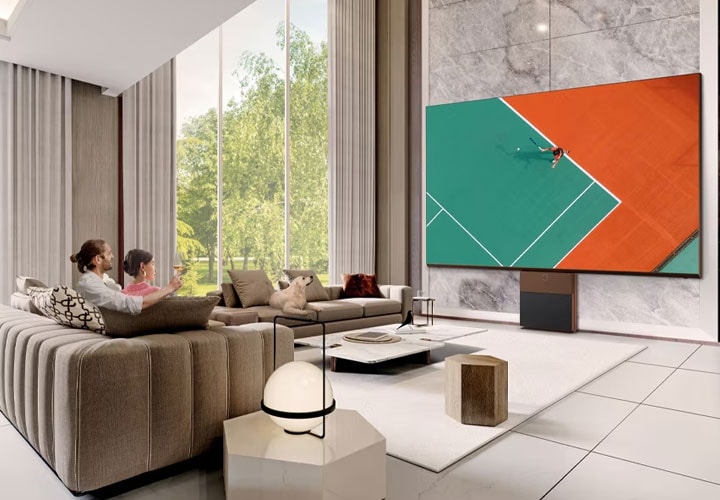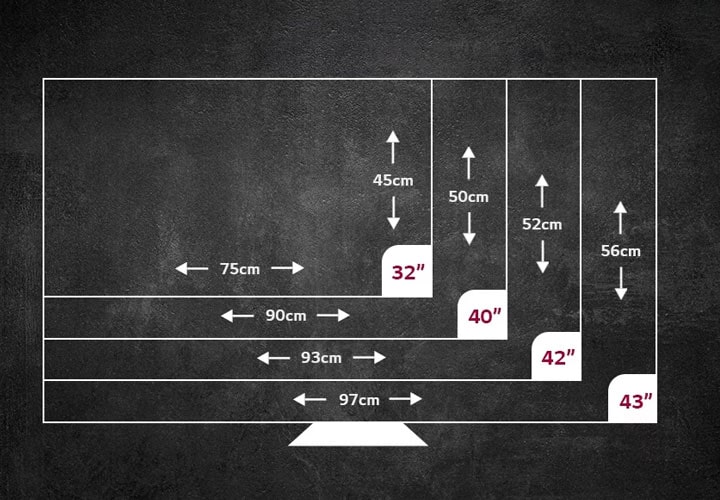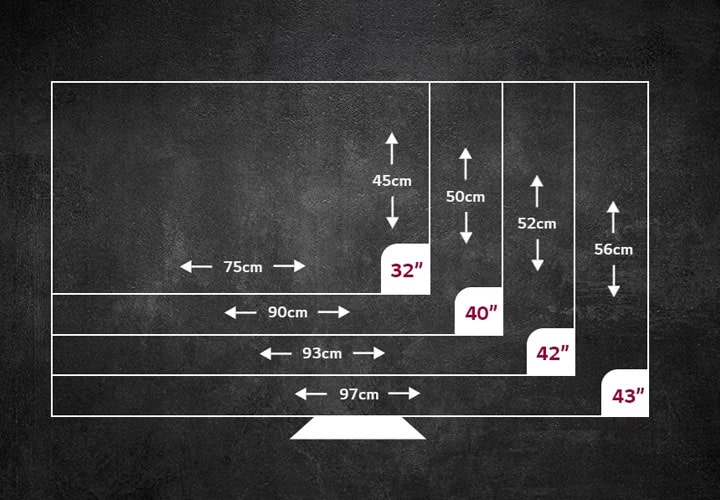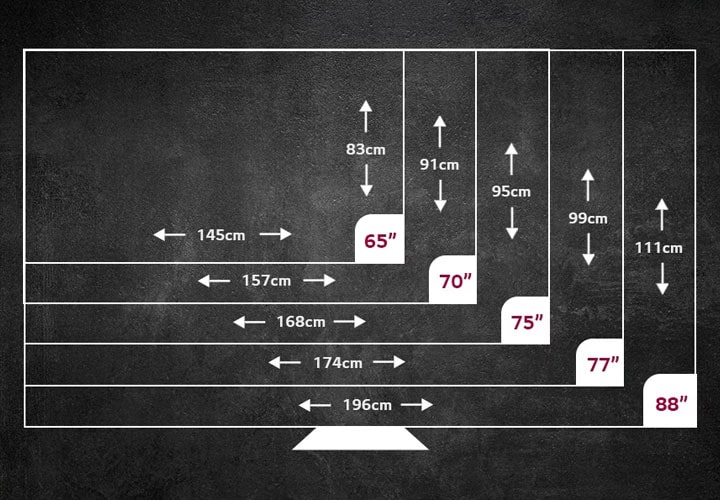We use cookies, including cookies from third parties, to enhance your user experience and the effectiveness of our marketing activities. These cookies are performance, analytics and advertising cookies, please see our Privacy and Cookie policy for further information. If you agree to all of our cookies select “Accept all” or select “Cookie Settings” to see which cookies we use and choose which ones you would like to accept.
HELPFUL HINTS
How to measure and read TV sizes
When it comes to TV sizes, there is an assumption that bigger always means better. But is that really the case? Read on to discover exactly how to measure a TV screen and read TV sizes (both in inches and cm) so you can choose the right TV for any space.
- Discover the true dimensions of TVs and the optimal viewing distance for any room
- Use this helpful formula to find the perfect viewing distance from your TV
- Find the ideal height to place a TV in order to help reduce eye strain
- The true dimensions for 32, 40, 42 and 43 inch television screens
- The true dimensions for 48, 49, 50, 55 and 60 inch television screens
- The true dimensions for 65, 70, 75, 77 and 88 inch television screens
How to understand TV dimensions and find the optimal viewing distance
The bigger the screen the better the viewing experience, right? Well, not always. A lot will depend on the size of the room, as sitting too close to the television can cause eye strain, especially when watching for a long period of time. Of course, on the other hand, you certainly don’t want to have to squint to see the image properly.
There is a formula for calculating TV size to optimal viewing distance which will help you find that sweet viewing spot. This can be found in the TV measurement chart below.
Table of TV sizes and distance from the screen
| TV size | Width | Height | Diagonal in cm | Recommended distance from the couch |
| 32 inches | 75 cm | 45 cm | 81.28 cm | 1.34 m |
| 40 inches | 90 cm | 50 cm | 101.6 cm | 1.68 m |
| 42 inches | 93 cm | 52 cm | 106.68 cm | 1.76 m |
| 43 inches | 97 cm | 56 cm | 109.22 cm | 1.81 m |
| 48 inches | 108 cm | 63 cm | 121.92 cm | 2 m |
| 49 inches | 110 cm | 64 cm | 123 cm | 2 m |
| 55 inches | 123 cm | 71 cm | 139.7 cm | 2.3 m |
| 60 inches | 134 cm | 77 cm | 152.4 cm | 2.5 m |
| 65 inches | 145 cm | 83 cm | 165.1 cm | 2.7 m |
| 70 inches | 157 cm | 91 cm | 177.8 cm | 2.9 m |
| 75 inches | 168 cm | 95 cm | 190.5 cm | 3.15 m |
| 86 inches | 194 cm | 111 cm | 218.4 cm | 3.6 m |
What’s the best height to place or mount the TV?
This may differ from room to room, but the ideal height is to have the middle of the TV screen at eye level or slightly below. This is because lifting your eyes is very tiring and can cause strain when settling in for a movie marathon or bingeing your favourite series.
Most experts recommend the centre of the TV to be around one metre from the floor, however, this may differ depending on how tall you are and the height of your sofa or chair.
Of course, there are some exceptions, if you tend to watch television while sitting on a recliner or while lying in bed, the TV should be mounted higher. This could be as high as 1.8m. But in this case, it is best to have an adjustable mount that you can easily alter the angle depending on your position.
Find the perfect viewing distance from your TV
Remember being told off as a kid for sitting too close to the TV? Well, it seems parents really do know best. Having your TV too close to your sofa can cause temporary eye strain or eye fatigue, especially when watching for hours on end. Similarly, if you are too far away and find yourself struggling to see the action, then your eyes will feel the strain.
Luckily there are some formulas to help you find the ideal viewing distance. If you have a Full HD TV, then one popular rule is to simply use 4.2cm of viewing distance for every inch of the diagonal screen size. Therefore, a 50-inch screen would require you to sit 2.1m away.
However, this can be slightly adjusted when it comes to 4K and Ultra HD TVs. This is because resolution also plays a role in determining the ideal distance from the screen. Due to the improved image clarity and sharpness, the conversion is much lower. In this case, you can use 2.1cm of viewing distance for every inch of the diagonal screen size.
Converting the dimensions of small and medium-sized TVs – 32, 40, 42, 43 inches to cm
- A 32-inch TV is approximately 75cm wide and 45cm high
- A 40-inch TV is approximately 90cm wide and 50cm high
- A 42-inch TV is approximately 93cm wide and 52cm high
- A 43-inch TV is approximately 97cm wide and 56cm high
What to consider before purchasing a 32-inch TV?
It doesn’t seem that long ago that this size TV was considered to be on the large side. Now very much in the small bracket, a 32-inch television still has many of the features that you will find in bigger models.
A great example of this is the LG 32LQ63006LA, which is a Full HD 32-inch TV that has an intelligent processor that enhances both colour and clarity. It also features AI Sound that delivers immersive sound quality, ThinQ AI – which allows you to easily control your TV with just your voice – and a built-in Game Optimiser to ensure you can easily change your settings to best fit the game you’re playing.
What to consider before purchasing a 40-43-inch TV?
A great choice for those with limited space, these mid-range TVs work exceptionally well in small or average-sized living rooms. The LG OLED48C55LA is a popular choice, thanks to its versatile size and advanced technology.
Delivering incredible picture quality, it features a Brightness Booster that uses high luminance to create an even crisper, bolder and brighter image.
Converting the dimensions of large TVs – 48, 49, 50, 55 and 60 inches to cm
If you want to understand just how big a TV is or if you’re looking to convert TV dimensions from inches to cm, then the guide below should help.
- A 48-inch TV is approximately 108cm wide and 63cm high
- A 49-inch TV is approximately 110cm wide and 64cm high
- A 50-inch TV is approximately 112cm wide and 65cm high
- A 55-inch TV is approximately 123cm wide and 71cm high
- A 60-inch TV is approximately 134cm wide and 77cm high
What to consider before purchasing a 48-60-inch TV?
As mentioned above, if you are thinking of buying a TV in this size range then you would ideally need to sit between 2-2.5m away from the screen. Fortunately, this distance is halved if you choose a 4K television. This means even an average living room could accommodate a 60-inch TV.
If you’re looking for an interesting design, the LG OLED48C55LA is a 48-inch 4K OLED TV that produces spectacularly vivid and accurate colours from any angle, in any space. It features AI Customisation for personalized picture and sound, and an ultra-slim design for sleek aesthetics. It is also packed with technology that movie buffs and gamers will love. Filmmaker mode automatically turns off picture processing settings that can make movies feel unnatural, while AMD FreeSync Premium ensures games can be enjoyed with almost imperceptible interruptions, stutters or input lag.
If you have space for a 55-inch 4K TV, then the LG OLED55G56LS is an excellent choice. It features Filmmaker Mode, Brightness Boost, and AI Picture Pro for stunning visuals, and Dolby Atmos for incredible sound. The TV also supports Dolby Vision 4K gaming at 120Hz, ensuring ultra-fast actions appear crisp and smooth. Its alpha 11 AI Processor enhances performance, while AI Customisation and AI Acoustic Tuning provide a personalized viewing and listening experience. With its sleek One Wall Design, it seamlessly integrates into any living space.
Converting the dimensions of the largest TVs – 65, 70, 75, 77 and 88 inches to cm
Is an 88-inch TV too big or just right? Convert TV dimensions from inches to cm easily with this guide.
- A 65-inch TV is approximately 145cm wide and 83cm high
- A 70-inch TV is approximately 157cm wide and 91cm high
- A 75-inch TV is approximately 168cm wide and 95cm high
- A 77-inch TV is approximately 174cm wide and 99cm high
- A 88-inch TV is approximately 196cm wide and 111cm high
What to consider before purchasing a TV that is 65-inches or above
At one time a screen this size would have been reserved for home cinemas, but thanks to the advances of OLED displays and higher resolutions, these huge TVs can now be found in living rooms around the world.
Even if you purchase an 88-inch TV, the perfect viewing distance is just over 1.8m if the model is 4K or higher. As long as you have enough space, there is no reason why you cannot go as big as possible. Of course, with that being said, you will also want to consider the screen height and make sure the middle of the TV screen is just below eye level.
Previously you would have also had to consider the viewing angle, especially in a large space where seats are not just directly in front of the TV. But OLED screens can be viewed with no luminance degradation even at drastic viewing angles. So all that’s left is to explore which option is right for you.
Should you want a 65-inch display, the 65 inch LG OLED evo C5 4K Smart TV 2025 is a great option for those with a tighter budget. It features an alpha 9 AI Processor Gen7 that ensures all content is optimised so that the picture quality is improved.
If your budget stretches further, then the 65 inch LG OLED evo G5 4K Smart TV 2025 is optimal for movie lovers and gamers alike. Featuring the alpha 11 AI Processor, this model redefines the experience through deep learning, graphics, and speed. Its AI capabilities offer a new level of customisation, creating picture and sound settings tailored to your unique taste and saving them to your profile.
One of the newest additions to the range, the LG QNED MiniLED QNED90 75 inch TV 2024 offers brand new technology that harnesses the best of QNED Color tech. It uses deep learning algorithms to send information to the backlight dimming blocks. It may sound technical, but what it delivers is a sharper and more natural image that minimises any halo effect.
But if you’re really looking to impress your friends and family, the 77 inch LG OLED evo G5 4K Smart TV 2025 is sure to do the job. This Gallery Design TV can be hung flush to the wall like a piece of art, whilst possessing an incredible amount of groundbreaking technology. Boasting uncompromised picture quality at any viewing angle, immersive sound and incredible clarity, it will impress whether bingeing your favourite series, watching the latest blockbuster or playing the newest video games.
Choosing a TV size according to room
An important factor to consider when buying a TV is the size of the room that you intend to keep it in. Finding the ideal TV size for your room is key to achieving an immersive viewing experience along with matching the aesthetics of the environment.
Large TVs
Larger rooms such as living spaces and family rooms can allow for setting up a larger entertainment space so that you get an immersive experience. A large room can usually accommodate a TV size bigger than 55-inches. When placed at an optimal viewing distance with a sound system that complements it, a big TV can provide a theatre-like viewing experience.
Medium TVs
Mid-size TVs are an excellent choice for those seeking an engaging viewing experience for both movies and gaming. They are ideal for medium-sized spaces or a large master bedroom. A suitable TV size for these room sizes is 50 or 55-inches.
Small TVs
Smaller TV sizes between 32-inch and 49-inch are ideal for small spaces like a kitchen or a compact room. It is not too big to take up too much room and crowd the space, while being large enough for a great viewing experience.
TV Sizes FAQs
What is the optimal viewing distance from your TV?
The optimal viewing distance depends on the TV size. There are some formulas to help you find the ideal viewing distance. For Full HD TVs, a popular rule is to use 4.2cm of viewing distance for every inch of the diagonal screen size. Therefore, a 50-inch screen would require you to sit 2.1 meters away.
However, for 4K and Ultra HD TVs, the improved image clarity and sharpness allow for a closer viewing distance. In this case, you can use 2.1cm of viewing distance for every inch of the diagonal screen size. For example, a 50-inch 4K TV would require you to sit approximately 1.05 meters away.
Refer to the recommended viewing distances from the couch in the TV size table provided above to help you choose the best TV size for your room. This ensures you get the most comfortable and engaging viewing experience.
What is the most popular TV size to buy?
As larger TVs have become more accessible and affordable, the popular TV sizes now range from 55 inches to 85 inches, offering an immersive viewing experience for living rooms and family rooms. These larger screens provide a more cinematic feel, making them perfect for movie nights and sports events. For those with smaller spaces like kitchens or small bedrooms, a 43-inch TV can still offer a great viewing experience without overwhelming the room. By choosing a larger TV, you can enjoy clearer, more detailed images and a more engaging viewing experience.
Is a 55 inch TV too big?
While it may seem like a 55-inch TV is large, it is a good starting point if you are considering getting a TV for your living room. It strikes a good balance between achieving an optimal viewing experience and not overcrowding your space.
Now you have a better understanding of how to measure TVs, how to read TV sizes and how to find the right TV viewing distance for any space. And thanks to modern technology that allows smaller rooms to house large TVs, don’t be afraid to dream big. All that’s left is to choose the right TV for you.
.jpg)







